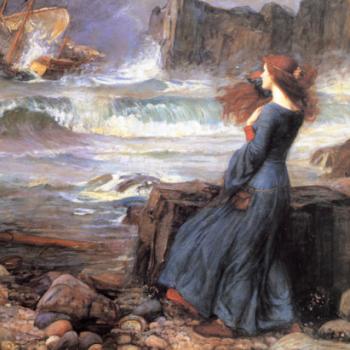
If you have never sent a text to the Boss and had autocorrect change a perfectly normal word to a very bad word, you have not yet known terror. When first it happens, you hope the Boss knows you do not speak that way and that autocorrect does funny things. Imagine the horror, however, if the Boss read your autocorrected post and liked it.
It is little known, very little known in fact, that the origins of Santa is an autocorrect error for Satan. Of course, the nineteenth century American origins of Santa could not be pure “autocorrect,” but the mistake was similar. Newspapers and books in the nineteenth century were set by hand using “type,” small pieces of lead that would print on the paper, and while the process was somewhat mechanized, much type was still set by hand. A piece of journalism could arrive letter perfect, but a bad typesetter could reduce it to rubble.
It happened, but first the backstory.
And so it was with the famous poem Twas the Night Before Christmas, which some have suggested*, is the first example of the modern “Santa” Claus. The actual title of the poem is “A Visit from St. Nicholas” and herein lies the problem. The typesetter did not know, as my own research has discovered that author “Clement Moore” had cribbed the poem from another now unknown author and the writings of Henry Livingston. The success of Dutch tales like The Legend of Sleepy Hollow had created a strong market for ghosts stories with ties to upstate New York and the poem aimed to fill the bill.
Here was the first bit and title as originally written*:
A Visit from Satan Nicholas
Twas the night before Christmas, when all thro’ the house
Not a creature was stirring, not even a mouse;
The stockings were hung by the chimney with care,
In hopes that Satan Nicholas soon would be there;
The children were nestled all snug in their beds,
While visions of sugar plums danc’d in their heads,
The poem was based on the popular description of the Devil as Old Nick. There was (apparently) a folk belief in New Amsterdam that “socks” would ward off Old Nick and so they would be placed near the chimney (the place of the infernal fire in the house) in hopes that when Old Nick came he would be warded off. Socks were used to symbolize the household being “shod in the gospel of peace.”
While folk tales leave little trace, the poem itself makes perfect sense if this interpretation is adopted universally. The rather sinister quiet that has descended on the house now makes sense, as does the aggressive and stealthy manner that Satan Nicholas comes to steal, rob, and destroy.
Sadly for the history of American horror, the type setter was from a liturgical church and nearsighted (of such coincidences history is made) and so mistook “Santa Nicholas” for “St. Nicholas.” St. Nicholas was, of course, the bishop of Myra and long associated with early December. Sadly for the organic unity of the poem, “St. Nicholas” has none of the characteristics of the historic Saint Nicholas. We have no reason to think the austere Bishop was fat, Lent gets rid of a jelly belly. He had no association with horned beasts like reindeer.
Now let yourself think of him as the Satan Nicholas:
- Satan Nicholas is associated with “clatter” just as Satan is in Milton’s Paradise Lost (see Pandemonium).
- Satan Nicholas brings a “wandering eye.” QED.
- Satan Nicholas rides a sleigh with reindeer. He is associated with cold as Satan is in Dante’s Inferno. This surprises many people who only think of Hell as fire. The ultimate level of Hell in Dante is frozen.
- Satan Nicholas lists his “familiars” including the Greek devil “Cupid.”
- He has a sleigh full of “toys.” Note the older definition of “toy:” a person treated by another as a source of pleasure or amusement rather than with due seriousness.
- He smokes.
- He is over weight (gluttony).
- He is dirty, not clean, as he is covered in “soot” (representing sin).
- He is inhuman (an “elf”). See Spencer for use of elf as a source of danger.
- He had a “broad face.”
- He is given to winking the eye.
- He gets no further than the “stockings” thus confirming the power of feet shod with peace.
- He wishes us a “happy” Christmas, not a joyful, blessed, or merry Christmas. He is the original Starbucks red cup.
Read the whole thing with the proper exegetical method and it will all be obvious to you. Santa Claus just is Satan’s claws in our holy day.
The mistake grew and any attempts to fix the original error only led to more as “Santa” was easily read as Satan by people who were preconditioned to see what they expected and not what was there.
What is the harm of “Santa” Claus story?
People came to believe that Satan was harmless imagination and play like Narnia, Oz, or Middle Earth.
Imagination, the act of sub-creation, is for beings created in the image of God. It is distinctly not for computers made out of meat who need proper programming to live well. We must pound the truth home . . . never allowing any use of figure, metaphors, or parable just like Jesus did.
People do not realize the danger of children associating good behavior with good outcomes.
What would happen if American youth came to associate being “nice” with good outcomes? We would get more nice people! This superficial niceness cannot save you, by grace you are saved, and a behavior has no value if it does not deal with eternal salvation. Why would we want neighbors who do not kill, just so they could get treats?
People do not realize that the grace Santa shows undermines our faith in a monetized world.
The world is tough and then you die. “Santa” is always giving gifts that are greater than those merited. No child has earned the sugar plums he receives and so indolence is inculcated.
People are incapable of separating imaginative play with reality . . .ever.
If you teach people to dream, then the dreams will win. Ask Joseph.
If you ever seen a dancing Santa, then you will know that this is really a dancing Satan. There is no doubt.
A century and one half later, Satan Claus is mainstream and the harm is done. The result of one typographical error, an autocorrect based on a misidentification of the character, has been the infiltration of evil into even the most innocent of homes.
Or maybe not.
———————-
*See The Origins of “Santa” Claus: An American Mythic Narrative from Moore to Barton. Peter R. Alexis (Alcinous Press, 1998)
———————-
This is, of course, a parody with a point.











